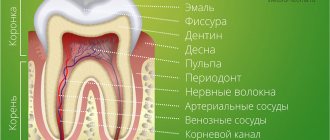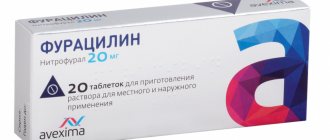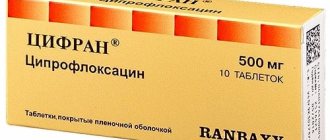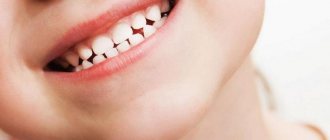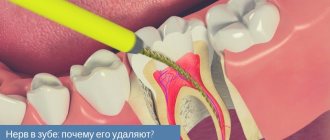Milk and molar teeth in children
Many people believe that there are no differences between permanent and temporary teeth, but this is not true. So, how to distinguish a baby tooth from a molar? At a minimum, their number differs (milk - 20, permanent, as a rule, 32). Temporary teeth have a light shade, while permanent teeth are naturally more yellow. Indigenous ones are also significantly larger in size than dairy ones - visually it is quite easy to distinguish them. Here are the most common questions asked by Internet users on this topic.
- Do children have molars?
Of course, there are, and at a certain point they begin to actively erupt. - How many molars do children have?
From 28 to 32 (the maximum set appears after all eights appear). - Which molars appear first in a child?
Typically, the lower central incisor erupts first. - At what age do children start to get their molars?
Usually, dentition renewal begins after 6–7 years, but there are no strict limits. - Do children lose molars?
By themselves - no, as a result of injuries and illnesses - yes. - What are the risks of removing a molar tooth in children?
As corny as it may sound, his loss. And yes, a new one will not grow. Everything is like adults. - What to do if a child has yellow molars?
Permanent teeth have a more yellowish tint than temporary teeth. Plaque on a child’s molars is normal, but hygiene should never be neglected. - What to do if a child has black molars?
When teething, baby teeth may have a black color (the so-called Priestley plaque, or pigment bacteria). However, this does not happen with molars. If they are black, go to the dentist immediately. - What to do if a child does not have molar buds?
This happens, but very rarely. Fortunately, with modern implantation and prosthetics technologies, the problem can be solved. - Is it normal for a child to have crooked molars?
Contact an orthodontist immediately: correcting a bite in childhood is much easier and faster than in adults. - Which teeth do children replace with molars?
All twenty, plus new molars appearing.
Removing or retaining wisdom teeth
Even before the “eight” stage, you can discuss with your doctor how many of your 4 wisdom teeth to keep and how many to remove. Dentists believe that it is necessary to preserve third molars when:
- no signs of crowded teeth;
- the crowns of wisdom teeth are positioned vertically;
- first and second molars are missing.
Factors such as the lack of free space on the jaw play in favor of removing “eights”: the existing teeth are tightly spaced, there are no plans to remove the molars, their condition is good or excellent.
Other indications for removal:
- incorrect position of the tooth crown - horizontal or inclined, creating pressure on the roots and crown of the adjacent molar;
- prolonged lack of progress in teething in the presence of intense symptoms;
- repeated inflammation and suppuration in the eruption area;
- caries of the crown of the third molar.
They can be removed both before and after eruption. This procedure is painless and does not take much time. The procedure is performed under local anesthesia. Some clinics use sedation to make the procedure as comfortable as possible for the patient.
Molars in children: symptoms of eruption
- Fever. When teething in children, body temperature may rise, usually not higher than 38 degrees.
- Itching and pain at the site where the molar appears. Various gels and ointments, as well as gum massage, will help relieve children from unpleasant sensations.
- Increased salivation and runny nose.
Important!
The growth of molars in children, especially at the initial stage, leads to weakened immunity. Take vitamins and do not forget about preventive visits to the dentist.
Associated symptoms
These symptoms do not appear very often, but they cannot be ignored. If the baby has a fever, an incomprehensible cough, or diarrhea, this can be either a sign of infection or a reaction of a weakened body to pathogenic microflora.
Diarrhea can be a sign not only of teething, but also of various diseases
When teeth are forming, the temperature usually lasts for 3-4 days at 38.5°C. This symptom is irregular, so fever in children should be periodic. If it persists for a long time, you need to show the child to the pediatrician. Some doctors believe that cold symptoms have nothing to do with teething and prescribe appropriate treatment for cough and fever.
If the temperature lasts longer than three days, you should consult a doctor.
Adults also don’t understand what cough and runny nose have to do with new teeth. The gums are directly connected to the blood supply to the nose and respiratory tract. As teeth form, blood flow increases in the mouth. The nasal mucosa is close, so its glands also begin to produce more mucus, which children try to get rid of. Remaining mucus settles into the throat, irritating the airways and causing a cough.
A runny nose may occur when teething
Another symptom is loose stools with a frequency of no more than 3 times a day. While scratching his gums, the baby constantly puts dirty fingers and the first objects he comes across into his mouth. In addition to infection, diarrhea is facilitated by increased salivation, which constantly flushes the intestines. If the stool is short-lived and does not contain blood, there is no need to worry about the child’s health. It is necessary to monitor his condition, since with a weakened immune system there is always a risk of developing an infection, which aggravates all the symptoms.
When does a child's molars come out?
Most parents are interested in the question: at what age do children’s molars begin to erupt? The first buds form in the fifth month of pregnancy. The exact timing of their appearance has not been determined and depends on the individual characteristics of the organism. Nevertheless, an approximate scheme for the eruption of molars in children exists. If the appearance of a permanent tooth is delayed for more than six months from the extreme threshold (especially after the loss of a baby tooth), consult a specialist. The doctor will take control of the process and be able to identify complications.
Pattern of growth of molars in children
In most cases, the permanent tooth appears 3 to 5 months after the temporary tooth falls out. The order of eruption of molars is in many ways similar to the appearance of milk teeth. The first molars in children are the central lower incisors. The upper permanent teeth develop later than the lower ones, if we consider them in pairs.
| Age | Eruption of molars in children |
2 years | There have been references in history where a child was born with one or more molars. Cases when molars erupted in a 2-3 year old child also occur, but are extremely rare (less than 1%). |
5 years | When a child is 5 years old, molars very rarely come out (less than 10% of the total). If a baby tooth falls out on its own at such an early age, then there is every reason to believe that a permanent one will soon appear in its place. |
6 years | The roots of baby teeth (especially the upper and lower incisors) begin to dissolve and the teeth fall out. Usually, it is at the age of 6 that a child’s first molar begins to erupt. |
7 years | At this age, the first lower molars in children (at least one of them) have already erupted and the incisors of the upper jaw are next in line. |
9 years | At the age of 9, a child’s second molar should definitely have time to appear. Some children acquire lateral incisors and even a premolar on one of the jaws. |
10 years | At the age of ten, children’s back molars begin to actively erupt (premolars, and a little later – molars and canines). |
13 years | At 12–13 years of age, children usually develop a full bite of permanent teeth. The last teeth to emerge are usually the upper canines and second molars. This does not apply to wisdom teeth, which appear in adulthood (after 17–18 years) or may not erupt at all. |
Difference between molars and premolars
The main difference between molar teeth and premolars is their location on the jaw.
Premolars are located closer to the front of the dentition, and molars are slightly moved inward. Their quantity also varies. There are always two premolars on each side of the upper and lower jaws. There can be either two or three molars. Still others are also called “wisdom teeth.” They grow later than others and often appear only at 20-25 years of age. This process is often accompanied by malaise and fever. However, not all people on earth have third ones. A certain genetic predisposition can cause the absence of wisdom teeth in the oral cavity.
Complications during teething
- Delay in the appearance of permanent teeth.
This may be due to genetic characteristics, immune system problems and a number of other diseases. - Uneven teeth and other malocclusions.
- Hyperdentia.
The child’s molar tooth (or teeth) grows in the second row. Hyperdentia, or supernumerary of teeth, is a fairly rare phenomenon, but requires the intervention of a dentist to eliminate the risk of malocclusion in a child.
Molar Differences
Often the surface of each molar tooth is shaped like a triangle. There is a certain number of tubercles on it, which take an active part in chewing food. The number of such tubercles may vary. Usually there are three, but sometimes there are more.
Such mounds are connected to each other by special ridges. On the upper and lower jaws the structure of these elements is different. In the upper dentition, the apex of the surface triangle is directed towards the tongue. This form is called a trigon. On the lower jaw, the apex of such a triangle is directed towards the cheek, which is called the trigonid. The size of the first and second types of teeth is practically the same.
Common problems with molars in children
| Problems with molars | How to fix? |
| Molar tooth is loose | A common occurrence with injuries and bruises. To avoid tooth loss, an urgent visit to the dentist and the application of a special splint are necessary, especially if the child’s molar sways when touched. |
| Broken molar tooth | Severe chips may require orthopedic treatment. If a child's front molar has chipped, aesthetic restoration with veneers or crowns may be required. |
| Molar caries | When the first molars erupt, it is important to prevent the occurrence of caries. If this happens, then it is necessary to stop the disease in its infancy, otherwise it will affect the deeper layers of the tooth. |
| A child's molar has fallen out | The most unpleasant thing that can happen. If a child knocks out a molar along with the root, then there is a chance to save it. To do this, you need to place the knocked out tooth back into the oral cavity, saline solution or into a glass of milk and urgently rush to the dentist (you need to do it within 30 - 40 minutes after the injury). If a child’s molar tooth has been removed, then there is only one way out - installing a prosthesis. |
Care instructions
Molars in children require even more careful care than in adults. Frail enamel is much more susceptible to the effects of carious bacteria and the external environment, and the love of sweets and carbonated drinks does not add strength to it. When children develop a permanent bite, parents need to take special control of oral hygiene and diet (at least until the age of 14–15, when the teenager himself begins to realize the importance of dental health). In general, there are no difficulties here: in order to keep children's teeth strong and healthy, you need to follow several basic points.
- Daily hygiene.
Brush your teeth at least twice a day, use dental floss and special rinses. - Proper diet.
Limit your intake of sweets and carbohydrates. - Preventative visits to the dentist at least once every six months.
If necessary, fluoridation and sealing of molars in children (so-called fissure sealing). - Do not forget to wear a protective mouth guard during active games and sports.
